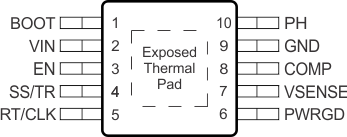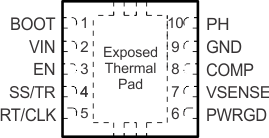SLVSAP3D December 2010 – February 2016 TPS57140-Q1
PRODUCTION DATA.
- 1 Features
- 2 Applications
- 3 Description
- 4 Revision History
- 5 Pin Configuration and Functions
- 6 Specifications
-
7 Detailed Description
- 7.1 Overview
- 7.2 Functional Block Diagram
- 7.3
Feature Description
- 7.3.1 Fixed Frequency PWM Control
- 7.3.2 Slope-Compensation Output Current
- 7.3.3 Low-Dropout Operation and Bootstrap Voltage (Boot)
- 7.3.4 Error Amplifier
- 7.3.5 Voltage Reference
- 7.3.6 Adjusting the Output Voltage
- 7.3.7 Enable and Adjusting Undervoltage Lockout (UVLO)
- 7.3.8 Slow-Start and Tracking Pin (SS/TR)
- 7.3.9 Overload Recovery Circuit
- 7.3.10 Constant Switching Frequency and Timing Resistor (RT/CLK Pin)
- 7.3.11 Overcurrent Protection and Frequency Shift
- 7.3.12 Selecting the Switching Frequency
- 7.3.13 How to Interface to RT/CLK Pin
- 7.3.14 Power Good (PWRGD Pin)
- 7.3.15 Overvoltage Transient Protection
- 7.3.16 Thermal Shutdown
- 7.3.17 Small-Signal Model for Loop Response
- 7.3.18 Simple Small-Signal Model for Peak-Current-Mode Control
- 7.3.19 Small-Signal Model for Frequency Compensation
- 7.4 Device Functional Modes
-
8 Application and Implementation
- 8.1 Application Information
- 8.2
Typical Application
- 8.2.1 Design Requirements
- 8.2.2
Detailed Design Procedure
- 8.2.2.1 Selecting the Switching Frequency
- 8.2.2.2 Output Inductor Selection (LO)
- 8.2.2.3 Output Capacitor
- 8.2.2.4 Catch Diode
- 8.2.2.5 Input Capacitor
- 8.2.2.6 Slow-Start Capacitor
- 8.2.2.7 Bootstrap Capacitor Selection
- 8.2.2.8 Undervoltage Lockout (UVLO) Set Point
- 8.2.2.9 Output Voltage and Feedback Resistors Selection
- 8.2.2.10 Compensation
- 8.2.3 Application Curves
- 9 Power Supply Recommendations
- 10Layout
- 11Device and Documentation Support
- 12Mechanical, Packaging, and Orderable Information
封装选项
机械数据 (封装 | 引脚)
散热焊盘机械数据 (封装 | 引脚)
订购信息
5 Pin Configuration and Functions
DGQ Package
10-Pin MSOP-PowerPAD
Top View

DRC Package
10-Pin VSON
Top View

Pin Functions
| PIN | I/O | DESCRIPTION | ||
|---|---|---|---|---|
| NAME | NO. | |||
| BOOT | 1 | O | A bootstrap capacitor is required between BOOT and PH pins. If the voltage on this capacitor is below the minimum required by the device, the output is forced to switch off until the capacitor is refreshed. | |
| COMP | 8 | O | Error-amplifier output and input to the output-switch current comparator. Connect frequency-compensation components to this pin. | |
| EN | 3 | I | Enable pin, internal pullup current source. Pull below 1.2 V to disable. Float to enable. Adjust the input undervoltage lockout with two resistors. | |
| GND | 9 | — | The GND pin is the ground pin. | |
| PH | 10 | I | The PH pin is the source of the internal high-side power MOSFET. | |
| PWRGD | 6 | O | An open-drain output, asserts low if output voltage is low due to thermal shutdown, dropout, overvoltage, or EN shutdown. | |
| RT/CLK | 5 | I | Resistor timing and external clock. An internal amplifier holds this pin at a fixed voltage when using an external resistor to ground to set the switching frequency. Pulling the pin above the PLL upper threshold causes a mode change whereby the pin becomes a synchronization input. Disabling of the internal amplifier occurs, and the pin is a high-impedance clock input to the internal PLL. If clocking edges stop, re-enabling of the internal amplifier occurs, and the mode returns to a resistor-set function. | |
| SS/TR | 4 | I | Slow-start and tracking. An external capacitor connected to this pin sets the output rise time. The voltage on this pin overrides the internal reference, allowing use of the pin for tracking and sequencing. | |
| VIN | 2 | I | The VIN pin is the input supply voltage which is from 3.5 to 42 V. | |
| VSENSE | 7 | I | The VSENSE pin is the inverting node of the transconductance (gm) error amplifier. | |
| Thermal pad | — | GND pin must have an electrical connection to the exposed pad on the printed-circuit board for proper operation. | ||